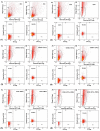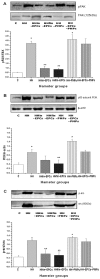Circulating endothelial progenitor cell and platelet microparticle impact on platelet activation in hypertension associated with hypercholesterolemia
- PMID: 23372649
- PMCID: PMC3556069
- DOI: 10.1371/journal.pone.0052058
Circulating endothelial progenitor cell and platelet microparticle impact on platelet activation in hypertension associated with hypercholesterolemia
Abstract
Aim: The purpose of this project was to evaluate the influence of circulating endothelial progenitor cells (EPCs) and platelet microparticles (PMPs) on blood platelet function in experimental hypertension associated with hypercholesterolemia.
Methods: Golden Syrian hamsters were divided in six groups: (i) control, C; (ii) hypertensive-hypercholesterolemic, HH; (iii) 'prevention', HHin-EPCs, HH animals fed a HH diet and treated with EPCs; (iv) 'regression', HHfin-EPCs, HH treated with EPCs after HH feeding; (v) HH treated with PMPs, HH-PMPs, and (vi) HH treated with EPCs and PMPs, HH-EPCs-PMPs.
Results: Compared to HH group, the platelets from HHin-EPCs and HHfin-EPCs groups showed a reduction of: (i) activation, reflected by decreased integrin 3β, FAK, PI3K, src protein expression; (ii) secreted molecules as: SDF-1, MCP-1, RANTES, VEGF, PF4, PDGF and (iii) expression of pro-inflammatory molecules as: SDF-1, MCP-1, RANTES, IL-6, IL-1β; TFPI secretion was increased. Compared to HH group, platelets of HH-PMPs group showed increased activation, molecules release and proteins expression. Compared to HH-PMPs group the combination EPCs with PMPs treatment induced a decrease of all investigated platelet molecules, however not comparable with that recorded when EPC individual treatment was applied.
Conclusion: EPCs have the ability to reduce platelet activation and to modulate their pro-inflammatory and anti-thrombogenic properties in hypertension associated with hypercholesterolemia. Although, PMPs have several beneficial effects in combination with EPCs, these did not improve the EPC effects. These findings reveal a new biological role of circulating EPCs in platelet function regulation, and may contribute to understand their cross talk, and the mechanisms of atherosclerosis.
Conflict of interest statement
Figures



Similar articles
-
Interaction of platelets with endothelial progenitor cells in the experimental atherosclerosis: Role of transplanted endothelial progenitor cells and platelet microparticles.Biol Cell. 2015 Jun;107(6):189-204. doi: 10.1111/boc.201400071. Epub 2015 Apr 30. Biol Cell. 2015. PMID: 25763472
-
Circulating microparticles and endothelial progenitor cells in atherosclerosis: pharmacological effects of irbesartan.J Thromb Haemost. 2012 Apr;10(4):680-91. doi: 10.1111/j.1538-7836.2012.04650.x. J Thromb Haemost. 2012. PMID: 22303879
-
Effects of transplanted circulating endothelial progenitor cells and platelet microparticles in atherosclerosis development.Biol Cell. 2016 Aug;108(8):219-43. doi: 10.1111/boc.201500104. Epub 2016 Apr 24. Biol Cell. 2016. PMID: 26968123
-
Endothelial microparticles after antihypertensive and lipid-lowering therapy inhibit the adhesion of monocytes to endothelial cells.Int J Cardiol. 2016 Jan 1;202:756-9. doi: 10.1016/j.ijcard.2015.10.035. Epub 2015 Oct 9. Int J Cardiol. 2016. PMID: 26476027 Review. No abstract available.
-
Platelet-derived chemokines in inflammation and atherosclerosis.Cytokine. 2019 Oct;122:154157. doi: 10.1016/j.cyto.2017.09.013. Epub 2017 Dec 1. Cytokine. 2019. PMID: 29198385 Review.
Cited by
-
Clinical Assessment of Intravenous Endothelial Progenitor Cell Transplantation in Dogs.Cell Transplant. 2019 Jul;28(7):943-954. doi: 10.1177/0963689718821686. Epub 2019 Apr 24. Cell Transplant. 2019. PMID: 31018670 Free PMC article.
-
Reverse-D-4F Increases the Number of Endothelial Progenitor Cells and Improves Endothelial Progenitor Cell Dysfunctions in High Fat Diet Mice.PLoS One. 2015 Sep 23;10(9):e0138832. doi: 10.1371/journal.pone.0138832. eCollection 2015. PLoS One. 2015. PMID: 26398523 Free PMC article.
-
Neuroimmune crosstalk in the pathophysiology of hypertension.Nat Rev Cardiol. 2019 Aug;16(8):476-490. doi: 10.1038/s41569-019-0178-1. Nat Rev Cardiol. 2019. PMID: 30894678 Review.
-
Platelets of Healthy Origins Promote Functional Improvement of Atherosclerotic Endothelial Progenitor Cells.Front Pharmacol. 2019 Apr 24;10:424. doi: 10.3389/fphar.2019.00424. eCollection 2019. Front Pharmacol. 2019. PMID: 31068820 Free PMC article.
-
Intravenous Administration of Allogenic Cell-Derived Microvesicles of Healthy Origins Defend Against Atherosclerotic Cardiovascular Disease Development by a Direct Action on Endothelial Progenitor Cells.Cells. 2020 Feb 12;9(2):423. doi: 10.3390/cells9020423. Cells. 2020. PMID: 32059493 Free PMC article.
References
-
- Schmidt-Lucke C, Rössig L, Fichtlscherer S, Vasa M, Britten M, et al. (2005) Reduced number of circulating endothelial progenitor cells predicts future cardiovascular events: proof of concept for the clinical importance of endogenous vascular repair. Circulation 111: 2981–2987. - PubMed
-
- Heiss C, Keymel S, Niesler U, Ziemann J, Kelm M, et al. (2005) Impaired progenitor cell activity in age-related endothelial dysfunction. J Am Col. Cardiol 45: 1441–1448. - PubMed
-
- Urbich C, Dimmeler S (2005) Risk factors for coronary artery disease, circulating endothelial progenitor cells, and the role of HMG-CoA reductase inhibitors. Kidney Int 67: 1672–1676. - PubMed
-
- Dernbach E, Randriamboavonjy V, Fleming I, Zeiher AM, Dimmeler S, et al. (2008) Impaired interaction of platelets with endothelial progenitor cells in patients with cardiovascular risk factors. Basic Res Cardiol 103: 572–581. - PubMed
-
- Georgescu A, Alexandru N, Andrei E, Titorencu I, Dragan E, et al. (2012) Circulating microparticles and endothelial progenitor cells in atherosclerosis; pharmacological effects of irbesartan. J Thromb Haemost 10(4): 680–91. - PubMed
Publication types
MeSH terms
Substances
LinkOut - more resources
Full Text Sources
Other Literature Sources
Medical
Miscellaneous

